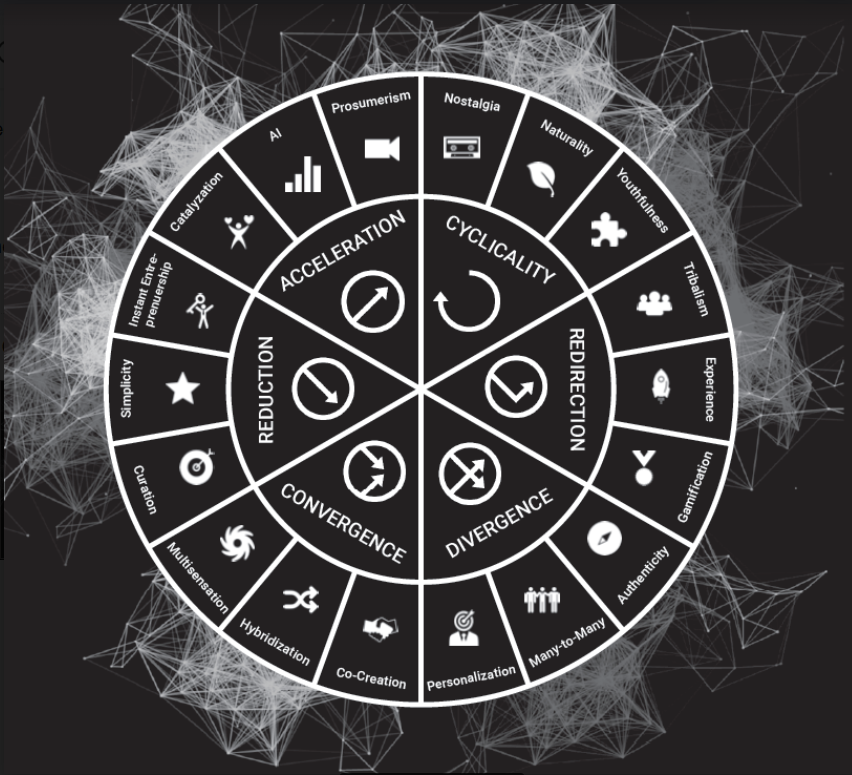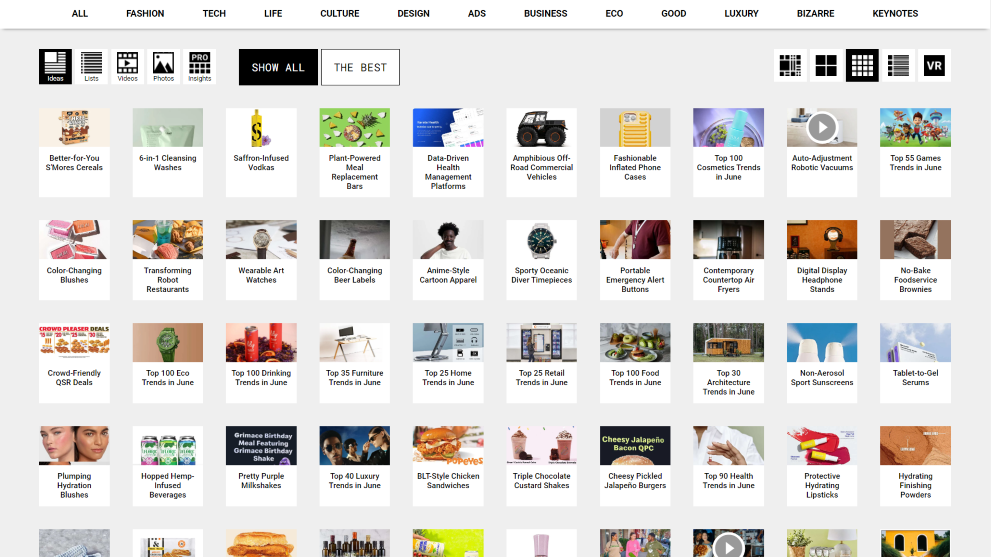Innovation Events

Excerpts From Create The Future + The Innovation Handbook
by Jeremy Gutsche - CEO of Trend Hunter
Whether you’re an entrepreneur, artist, bureaucrat, or marketer, your goal probably involves creating something that “connects” with other human beings.
In the pursuit of something that connects, your creativity and effectiveness are likely hindered by organizational structure, uncertainty, and unexploited opportunity.
To break free of these constraints, you need a trend-spotting toolkit, a plan of attack that will help you filter through the noise and increase your likelihood of “connecting” new products and services with your customers.
Part of this toolkit involves your personal commitment to seeking inspiration proactively. Try saying it out loud: “I will relentlessly pursue new ideas. I will feed my insatiable hunger for innovation. I will expose myself to the fringe. I will be cutting edge and spectacular.”

You might get inspired by a single great idea. At Trend Hunter, we’ve published roughly 480,597 articles about individual ideas. Seeing something inspiring can be an insightful way to come up with a new idea. The caveat is that the world is overwhelmingly full of individual ideas, so it can be difficult to discern which idea is right for you, and one single example could be fleeting. A single idea would be something like the first caffeinated soft drink, Red Bull.
If you can identify a group of several ideas that are very appealing and similar, you are likely identifying a cluster of opportunity, or as professionals call it, a consumer insight. At Trend Hunter, our 480,597 Ideas have resulted in just 10,809 Consumer Insights. An example would be caffeinated beverages, caffeinated potato chips, caffeine pills, and caffeinated chocolate bars. When these four started spiking in popularity, your consumer insight might have been called “alternative caffeination.” Based on the momentum behind these alternatives, you could predict new products and services that would probably trend positively for one to five years.
If you look at everything impacting our future, there are probably just 50 megatrends that explain every major change in consumer demand. Instead of predicting what’s hip next year, megatrends explain how our world changes in the next 3 to 10 years. At Trend Hunter, we are constantly reevaluating which megatrends are the most important and publicly reveal just 18 Megatrends that we believe have the most sway.
Every new innovation is like a splash in water. Each splash creates ripples of opportunity. These are the Six Patterns of Opportunity, and you can use them to classify every major innovation or to predict what innovations will happen next. There are only six possible patterns, which never change.
Tactics:
1. TRAVEL: “I look for subcultures of cool and emerging cool. To find this, travel is the #1 thing for me. Connecting with different cultures and subcultures is important.”
—Shaheen Sadeghi, Cofounder of Quiksilver, Awesome Dude
2. PURSUE CURIOSITIES: “Create something that you would use and answers the question, ‘Wouldn’t it be cool if . . . ?’ Do not depend on focus groups and market research. That’s for losers.”
—Guy Kawasaki, Venture Capitalist, Author, Honorary Trend Hunter
3. CARE: “Innovation has no agenda, no plan, no rigid structure. It’s about doing something you care about. I’ve found that people who truly care are the ones that are most likely to be innovators.”
—Seth Godin, Bestselling Author
4. REBEL: “You need a culture of rebellion, an elastic-sided sandbox, a mindset that rules are made to be tested . . . Inevitably you do need process and planning elements to create a culture of innovation . . . But if you’re not stretching the boundaries with spontaneous ideas, you’re going nowhere quick.”
—Kevin Roberts, CEO of Saatchi & Saatchi, Funny as Hell
5. RANDOMIZE: “Focus on what you love, but don’t limit yourself to only things that you love. Subscribe to new magazines, download podcasts on a topic that has nothing to do with your current life, go to lectures by people at the top of their field—even if you’ve never heard of their field. Get books on tape, and follow websites that gather interesting information. (I get Cool News of the Day from Reveries.com and Trend Candy from TrendHunter.com).”
—Tom Kelley, General Manager of IDEO, World’s Leading Design Firm
6. SHARE IDEAS: “I try to act on as many of my ideas as possible, from a simple blog post to starting a company. Simply writing them down, usually in public, is a great discipline, and once they’re out there they tend to improve.”
—Chris Anderson, Former Editor-in-Chief of Wired
7. FORM AN IDEOLOGY: “The principle is that you find a common point of pain or passion and you get people organized around that.”
—Rod Beckstrom, Coauthorof The Starfish and the Spider, Inspirational Guy
8. HUNT FOR COOL: “Through cool hunting, marketers are able to identify the cultural meaning of trends ahead of competitors. . . . Traditional product positioning has been based on physical attributes. . . . Cultural branding is based on positioning the product on the cultural meanings to consumers. This makes cool hunting the new source of product positioning.”
—Jay Handleman, Queen’s University Professor, Teacher Who Inspired Me to Start TrendHunter.com by Showcasing Malcolm Gladwell’s Article “The Coolhunt”
9. TALK TO STRANGE PEOPLE: “It’s also important, I think, to communicate, whether by email, in person, or on the phone, to a wide variety of people. Talking with only the usual suspects can become an echo chamber.”
—Dan Pink, Only Guy I Know to Make a Manga Cartoon Business Book
10. CONSUME POP CULTURE: “I am a voracious consumer of pop culture, whether it’s books, magazines, art, blogs, websites, or serialized television. A key to being creative is to pay attention to what’s going on around you. Constant stimulation and being open to new ideas are musts.”
—Marian Salzman,CMO of Porter Novelli, Renowned Futurist
11. SEEK POSITIVITY: “Consciously seek positivity. Often the media is abuzz about something negative, like Iran, for example. I hunt specifically for a unique angle that offers a positive twist, such as fashion in Iran, the underground music scene in Tehran, or the efforts of eco-bloggers in that part of the world.”
—Bianca Bartz, Original Editor of TrendHunter.com (4,000 Published Articles)
12. SOCIALIZE AND CONNECT: Find colleagues and friends who will keep you challenged in the quest for new ideas.
13. SPEND A DAY: “Spend a day immersed in your target consumer’s life and environment— true ethnography!”
—Marianne McLaughlin, Senior Manager of Global Consumer Insights, New Balance
14. GO ON A TREND SAFARI: “Real life experiences, like safaris (to experience other industries and cultures), inspire me. Try different geographies, like comparing businesses in Shanghai versus London.”
—Maria Åkerlund, Macro Insights Manager, Ikea
15. CREATE A PERCEPTUAL MAP OF COMPETITORS: What needs do your competitor products satisfy? “Create a perceptual mapping of competitive products to identify white space. Repeat the exercise thinking of micro metrics.” Also consider, “Move further up the continuum of your product category. Being in consumer packaged goods, I’ll tour restaurants, bars, and food trucks.”
—Lisa Tirino, Director of Innovation, Ocean Spray
16. SHOP ALONGSIDE YOUR CUSTOMER: “I host monthly ‘Shop Alongs,’ where we shop alongside our customers. Colleagues get a chance to experience shopping and study buying behaviors to help design and develop products.”
—David Dombrowski, Director of Industrial Design & Innovation, GSK/Pfizer
17. PEOPLE WATCH: “I visit competitors and smaller shops to study what customers are doing.”
—Lauren Simoneschi, Consumer and Sensory Specialist, Nestlé
18. TEACH: Surprisingly, one of the best ways to really challenge your presumptions is to teach or mentor. You’ll form a clear perspective as you force yourself to articulate important answers.
19. STUDY OTHER CATEGORIES: “I get inspired looking to other categories of products and services and visualize how I can apply insights to my job and make it better.”
—Nikolaos Ananikas, Senior Brand Manager, Coca-Cola
20. ASK QUESTIONS: “Have a workshop where only questions can be asked. No answers can be presented. Then have a separate workshop where everyone brings solutions.”
—Tom Kneubuehl, Digital Strategy Consultant, American Family Insurance
21. VISIT TREND HUNTER: “At TrendHunter.com, find out what’s cool before it’s cool.”
—MTV Live
TrendHunter.com has more than 400,000 cutting-edge ideas, broken into 100+ categories,including design, pop culture, advertising, modern art, and innovation. You can explore ideas on the site, sign up for a free Weekly Trend Report, or start your own Trend Hunter portfolio to collect and publish your favorite ideas.